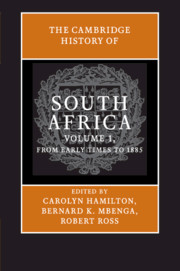Book contents
- Frontmatter
- 1 The Production of Preindustrial South African History
- 2 The Appearance of Food Production in Southern Africa 1,000 to 2,000 Years Ago
- 3 Farming Communities of the Second Millennium: Internal Frontiers, Identity, Continuity and Change
- 4 Khoesan and Immigrants: The Emergence of Colonial Society in the Cape, 1500–1800
- 5 Turbulent Times: Political Transformations in the North and East, 1760s–1830s
- 6 From Slave Economy to Settler Capitalism: The Cape Colony and Its Extensions, 1800–1854
- 7 From Colonial Hegemonies to Imperial Conquest, 1840–1880
- 8 Transformations in Consciousness
- Index
- References
4 - Khoesan and Immigrants: The Emergence of Colonial Society in the Cape, 1500–1800
Published online by Cambridge University Press: 28 September 2010
- Frontmatter
- 1 The Production of Preindustrial South African History
- 2 The Appearance of Food Production in Southern Africa 1,000 to 2,000 Years Ago
- 3 Farming Communities of the Second Millennium: Internal Frontiers, Identity, Continuity and Change
- 4 Khoesan and Immigrants: The Emergence of Colonial Society in the Cape, 1500–1800
- 5 Turbulent Times: Political Transformations in the North and East, 1760s–1830s
- 6 From Slave Economy to Settler Capitalism: The Cape Colony and Its Extensions, 1800–1854
- 7 From Colonial Hegemonies to Imperial Conquest, 1840–1880
- 8 Transformations in Consciousness
- Index
- References
Summary
In the last years of the fifteenth century, Southern Africa’s contacts with the world outside the South African subcontinent took on new forms. No longer was maritime trade maintained only on the shores of the Indian Ocean. In this chapter the first results of that change are discussed, primarily with regard to the period after the establishment of a Dutch colony at the Cape of Good Hope. This was a period that saw the destruction of Khoesan independence through most of the region to the south of the Gariep River and simultaneously, in close relation to this, the establishment of colonial society within the same space. That system was a relatively minor part of the empire of the Vereenigde Oost-indische Compagnie, the Dutch East India Company, or VOC, but it increasingly developed its own dynamics based on the land of the dispossessed Khoesan, and on the labor in part of the Khoesan but primarily of imported slaves and employees of the company.
Initially, the historiography of this period celebrated European colonization and was concerned with the details of colonial rule and settlement. As might be expected, the revitalization of the historiography came in the first instance through discussions of the Khoesan, of slave society, and of the historical geography of colonial farming and pastoralism. Much of this work came together in the two editions of The Shaping of South African Society. Nevertheless, neither these works nor the subjects with which they deal can be considered distinct from each other.
- Type
- Chapter
- Information
- The Cambridge History of South Africa , pp. 168 - 210Publisher: Cambridge University PressPrint publication year: 2009
References
- 3
- Cited by



